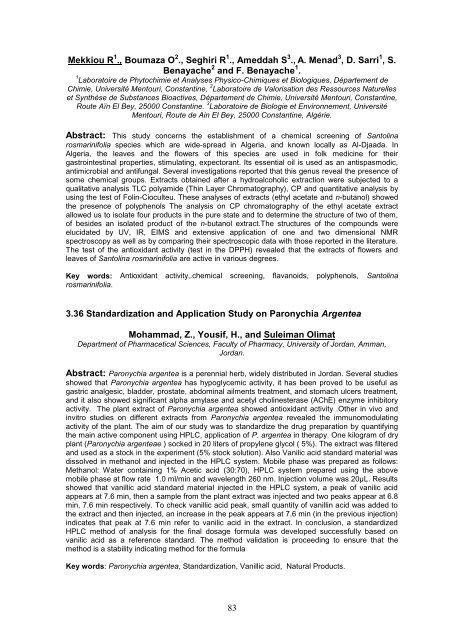Abstract Book - 3rd International Symposium on Medicinal Plants ...
Abstract Book - 3rd International Symposium on Medicinal Plants ...
Abstract Book - 3rd International Symposium on Medicinal Plants ...
Create successful ePaper yourself
Turn your PDF publications into a flip-book with our unique Google optimized e-Paper software.
Mekkiou R 1 ., Boumaza O 2 ., Seghiri R 1 ., Ameddah S 3 ., A. Menad 3 , D. Sarri 1 , S.<br />
Benayache 2 and F. Benayache 1 .<br />
1 Laboratoire de Phytochimie et Analyses Physico-Chimiques et Biologiques, Département de<br />
Chimie, Université Mentouri, C<strong>on</strong>stantine, 2 Laboratoire de Valorisati<strong>on</strong> des Ressources Naturelles<br />
et Synthèse de Substances Bioactives, Département de Chimie, Université Mentouri, C<strong>on</strong>stantine,<br />
Route Aïn El Bey, 25000 C<strong>on</strong>stantine. 3 Laboratoire de Biologie et Envir<strong>on</strong>nement, Université<br />
Mentouri, Route de Ain El Bey, 25000 C<strong>on</strong>stantine, Algérie.<br />
<str<strong>on</strong>g>Abstract</str<strong>on</strong>g>: This study c<strong>on</strong>cerns the establishment of a chemical screening of Santolina<br />
rosmarinifolia species which are wide-spread in Algeria, and known locally as Al-Djaada. In<br />
Algeria, the leaves and the flowers of this species are used in folk medicine for their<br />
gastrointestinal properties, stimulating, expectorant. Its essential oil is used as an antispasmodic,<br />
antimicrobial and antifungal. Several investigati<strong>on</strong>s reported that this genus reveal the presence of<br />
some chemical groups. Extracts obtained after a hydroalcoholic extracti<strong>on</strong> were subjected to a<br />
qualitative analysis TLC polyamide (Thin Layer Chromatography), CP and quantitative analysis by<br />
using the test of Folin-Cioculteu. These analyses of extracts (ethyl acetate and n-butanol) showed<br />
the presence of polyphenols The analysis <strong>on</strong> CP chromatography of the ethyl acetate extract<br />
allowed us to isolate four products in the pure state and to determine the structure of two of them,<br />
of besides an isolated product of the n-butanol extract.The structures of the compounds were<br />
elucidated by UV, IR, EIMS and extensive applicati<strong>on</strong> of <strong>on</strong>e and two dimensi<strong>on</strong>al NMR<br />
spectroscopy as well as by comparing their spectroscopic data with those reported in the literature.<br />
The test of the antioxidant activity (test in the DPPH) revealed that the extracts of flowers and<br />
leaves of Santolina rosmarinifolia are active in various degrees.<br />
Key words: Antioxidant activity,.chemical screening, flavanoids, polyphenols,<br />
rosmarinifolia.<br />
Santolina<br />
3.36 Standardizati<strong>on</strong> and Applicati<strong>on</strong> Study <strong>on</strong> Par<strong>on</strong>ychia Argentea<br />
Mohammad, Z., Yousif, H., and Suleiman Olimat<br />
Department of Pharmacetical Sciences, Faculty of Pharmacy, University of Jordan, Amman,<br />
Jordan.<br />
<str<strong>on</strong>g>Abstract</str<strong>on</strong>g>: Par<strong>on</strong>ychia argentea is a perennial herb, widely distributed in Jordan. Several studies<br />
showed that Par<strong>on</strong>ychia argentea has hypoglycemic activity, it has been proved to be useful as<br />
gastric analgesic, bladder, prostate, abdominal ailments treatment, and stomach ulcers treatment,<br />
and it also showed significant alpha amylase and acetyl cholinesterase (AChE) enzyme inhibitory<br />
activity. The plant extract of Par<strong>on</strong>ychia argentea showed antioxidant activity .Other in vivo and<br />
invitro studies <strong>on</strong> different extracts from Par<strong>on</strong>ychia argentea revealed the immunomodulating<br />
activity of the plant. The aim of our study was to standardize the drug preparati<strong>on</strong> by quantifying<br />
the main active comp<strong>on</strong>ent using HPLC, applicati<strong>on</strong> of P. argentea in therapy. One kilogram of dry<br />
plant (Par<strong>on</strong>ychia argenteae ) socked in 20 liters of propylene glycol ( 5%). The extract was filtered<br />
and used as a stock in the experiment (5% stock soluti<strong>on</strong>). Also Vanilic acid standard material was<br />
dissolved in methanol and injected in the HPLC system. Mobile phase was prepared as follows:<br />
Methanol: Water c<strong>on</strong>taining 1% Acetic acid (30:70), HPLC system prepared using the above<br />
mobile phase at flow rate 1.0 ml/min and wavelength 260 nm. Injecti<strong>on</strong> volume was 20µL. Results<br />
showed that vanillic acid standard material injected in the HPLC system, a peak of vanilic acid<br />
appears at 7.6 min, then a sample from the plant extract was injected and two peaks appear at 6.8<br />
min, 7.6 min respectively. To check vanillic acid peak, small quantity of vanillin acid was added to<br />
the extract and then injected, an increase in the peak appears at 7.6 min (in the previous injecti<strong>on</strong>)<br />
indicates that peak at 7.6 min refer to vanilic acid in the extract. In c<strong>on</strong>clusi<strong>on</strong>, a standardized<br />
HPLC method of analysis for the final dosage formula was developed successfully based <strong>on</strong><br />
vanilic acid as a reference standard. The method validati<strong>on</strong> is proceeding to ensure that the<br />
method is a stability indicating method for the formula<br />
Key words: Par<strong>on</strong>ychia argentea, Standardizati<strong>on</strong>, Vanillic acid, Natural Products.<br />
83

















